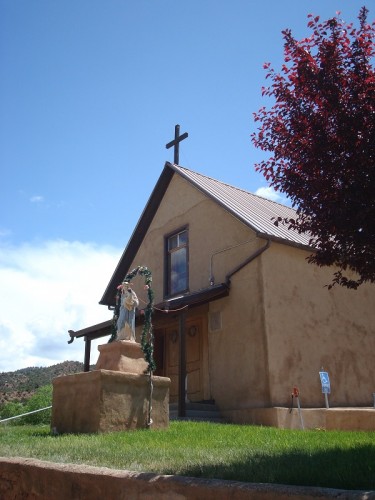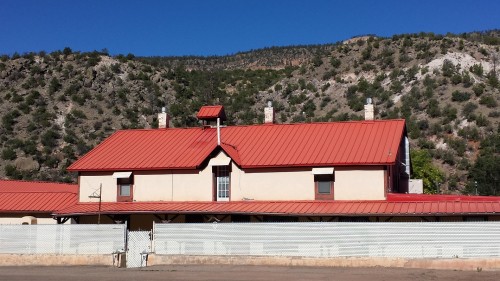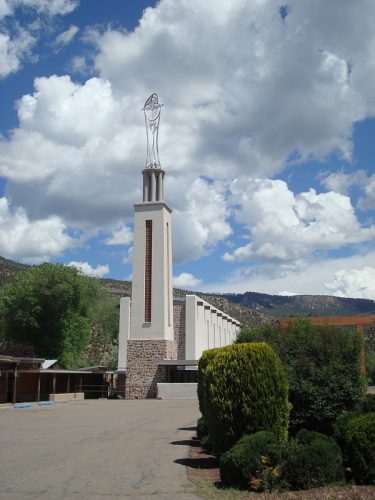The Catholic Church has been a major presence in the Valley since the 17th century. More recently four facilities have had a role in the community. First, the little church in Jemez Springs, Our Lady of the Assumption, has served a congregation since the early 1900s. Then in the 1940s, two religious communities were established here: Servants of the Paraclete and Handmaids of the Precious Blood. In the 1960s, a large chapel, Mary-Mother of Priests, was built adjacent to Via Coeli. Following are their stories.
Our Lady of the Assumption Catholic Church

Franciscan priests had been a presence in the Jemez Valley for 300 years when Our Lady of the Assumption (Nuestra Senora de la Asuncion) Catholic Church was established in Jemez Springs in 1906. Led by the Otero and Abousleman families, the people of the Village built the church. At that time, it was part of the mission system established by the Franciscans at Jemez Pueblo, which also served the little churches at San Ysidro, Ponderosa and Cañon.
Until recently, the church celebrated an annual fiesta, which was always commemorated by a bulletin which contained tidbits about local history, as well as information about the church. Click on the date to see copies of Fiesta bulletins from 1987, 1989, 1992, and 2005.
According to a story in the 2005 Fiesta bulletin,
[W]en the church was completed on August 15, a Franciscan priest from Jemez Pueblo rode horseback into the Village to sing vespers, Indian dances were held, food was piled high on tables for visitors and a grand baile (dance) took place that night. So began the Fiesta tradition!
In 1947, the church became part of the Archdiocese of Santa Fe, and two priests came to Jemez Springs: Rev. Gerald Fitzgerald and Rev. Louis P. Barcelo. The latter was quoted as saying that the “little church was sadly in need of funds to make needed improvements and repairs.”
Servants of the Paraclete/Handmaids of the Precious Blood
For many years, two Catholic religious orders were a major presence in Jemez Springs. Their founder was Fr. Gerald Michael Cushing Fitzgerald, who was inspired by an incident early in his priesthood. The story goes that while a parish priest in Massachusetts in the mid-1930s, Fr. Fitzgerald encountered a hungry homeless man who told him that he had once been a priest. It was at that point that Fr. Fitzgerald realized that priests needed help with the same problems as the rest of us.
In 1947 he fulfilled his long-held dream to provide a ministry for priests and brothers who struggled with addiction to drugs and/or alcohol. The archdiocese purchased the Esperanza Hotel and grounds in Jemez Springs across from the ruins of a 16th century mission church (now Jemez Historic Site) and named the new healing center Via Coeli (Way to Heaven). Their dormitory-style living quarters was named Villa Louis Martin. North of Soda Dam, a large residence sited on 26 acres was purchased to provide additional housing; this complex was named Lourdes. An in-depth account of Fr. Fitzgerald’s path to Jemez Springs appeared in the January 1, 1997 Jemez Thunder. That year marked the 50th anniversary of the founding of the religious communities.
The two religious orders established by Fr. Fitzgerald were Servants of the Paraclete and Handmaids of the Precious Blood.
Servants of the Paraclete. The Paraclete is a congregation of vowed priests and brothers dedicated to minister to fellow priests and religious by, in the words of their online vision statement, “offering spiritual, holistic programs for vocational renewal through spiritual direction, individual and group therapy, supervised living, ongoing education and formation, prayer and contemplation.“ The Handmaids is described on their website as “a contemplative community with pontifical status, dedicated to the sanctification of priests and committed to living an intense life of prayer.”
At its founding, Via Coeli provided what was called “a therapeutic treatment model” for those receiving treatment, who were referred to as “guests.” Treatment focused on prayer and meditation and little or no psychological or psychiatric treatment. This became known as the “Jemez Program,” and the model was adopted by religious congregations elsewhere. Later, a more traditional 12-step program was introduced and eventually professionals were contracted to provide mainstream therapy. Over the years, hundreds if not thousands were treated in Jemez Springs.
In the early 1990s, it became known that some priests in treatment in Jemez Springs were pedophiles, part of the nation-wide (ultimately international) scandal that rocked the Catholic Church. Due to community pressure and notoriety created by outside publicity, the Paraclete stopped accepting pedophiles. Eventually, all the “guests” who required treatment for addictions and sexual disorders were moved to other facilities staffed with professionals. The center struggled with the costs of litigation and eventually became a retirement home for a handful of aged priests who now live at Lourdes.
Fr. Fitzgerald made many contributions to the community. The first telephone switchboard was at the Paraclete, and for a time the post office operated out of there. He donated food and clothing to those in need throughout the Valley. He was also named honorary fire chief. The land on which the Village complex now stands was donated when the Village was incorporated in 1955, and the park was named in his honor. Throughout the years, Fr. Fitzgerald made many additional land purchases, and eventually the Paraclete became one of the largest property holders in the Valley. According to an article in the Jemez Thunder, March 1995, their holdings at that time was about 2,600 acres, reduced from when they owned land as far south as the Jemez Springs Village limits.

Handmaids of the Precious Blood. The Handmaids was founded to pray for all priests and especially the guests at Via Coeli. Their monastery, initially the Otero home, was called Cor Jesu (Heart of Jesus). Initially, the nuns, many of whom had medical training, operated a clinic which served those in residence at the Paraclete and was later opened to local residents. (That building was later converted to living quarters and is now the owners’ residence at Jemez Canyon Inn.) Later, the Handmaids became cloistered and devoted their lives solely to prayer for the priests and brothers in treatment. They continue to wear a full-length wine red habit, a white cape-like scapular, and a long white veil. The Mother Superior accompanied by one or two others, all wearing this habit, was occasionally seen at the Jemez Springs Post Office or driving their van to Albuquerque for shopping or medical appointments. The convent was closed in 2015, and the remaining nuns relocated to Tennessee.

Mary, Mother of Priests. In 1962, Fr. Fitzgerald built a shrine church, named Mary, Mother of Priests at the Via Coeli location. A bell tower topped with a metal sculpture of the Virgin Mary holding an infant became a local landmark. The chapel continues to be used for services and special programs, most notably the annual Christmas concert, a popular holiday event attended by a large audience from the community.
In 2004, the Paraclete closed, and the property was made available to other religious groups as a retreat center. The statue broke and was removed from atop the bell tower and installed it on the ground next to the chapel. When the Valles Caldera National Preserve was formed in 2000, they leased the property and remodeled the facilities into administrative offices and an education center. When the Valles Caldera became part of Bandelier National Monument, the Valles Caldera offices were closed and Via Coeli once again became a monastery and retreat center.